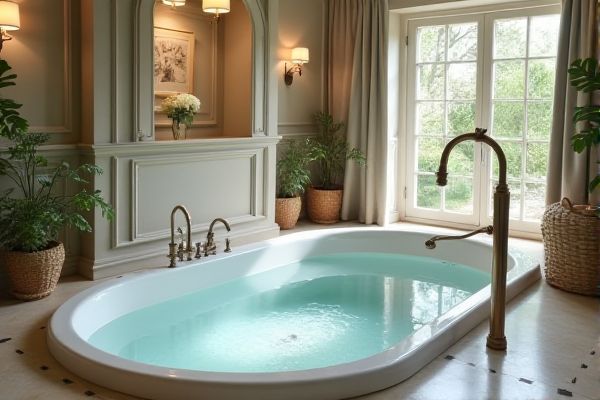
Soaking tubs offer deep, still water for ultimate relaxation and muscle relief, while whirlpool tubs provide targeted water jets for hydrotherapy and massage benefits. Explore the differences in design, function, and health advantages to determine which tub best suits Your bathing experience.
Table of Comparison
| Feature | Soaking Tub | Whirlpool Tub |
|---|---|---|
| Purpose | Deep relaxation through immersion | Hydrotherapy with water jets |
| Design | Simple, deep basin for full-body soak | Tubs with built-in water jet systems |
| Water Jets | No | Yes, multiple jets targeting muscles |
| Therapeutic Benefits | Relaxation and stress relief | Muscle massage, improved circulation |
| Installation Cost | Lower | Higher, due to plumbing and electrical needs |
| Maintenance | Easy, minimal upkeep | Requires regular cleaning of jets and pumps |
| Energy Use | Minimal | Higher, due to jet motor usage |
| Ideal For | Users seeking simple soaking experience | Users needing targeted hydrotherapy benefits |
Introduction to Soaking Tubs and Whirlpool Tubs
Soaking tubs are designed for deep, relaxing immersion with a focus on comfort and quietude, often featuring simple, ergonomic shapes. Whirlpool tubs incorporate jets that provide a massaging effect, targeting muscle relaxation and therapeutic benefits with adjustable water pressure. Choosing between these options depends on whether you prioritize a tranquil soak or an invigorating hydrotherapy experience for your bathroom.
Key Differences Between Soaking Tubs and Whirlpool Tubs
Soaking tubs offer deep, quiet immersion designed for relaxation and ease of use without jets or bubbles, focusing on simple stress relief and muscle relaxation. Whirlpool tubs incorporate powerful water jets that provide hydrotherapy benefits by targeting muscles and improving circulation through massage-like action. While soaking tubs emphasize a serene and minimalist bathing experience, whirlpool tubs deliver therapeutic effects ideal for individuals seeking physical rejuvenation and pain relief.
Design and Aesthetic Appeal
Soaking tubs feature sleek, minimalist designs that emphasize deep, uninterrupted space for full body immersion, often crafted from materials like porcelain or stone for a timeless aesthetic. Whirlpool tubs incorporate built-in jets and controls, which add a modern, spa-like appeal but may interrupt minimalist lines with visible hardware and piping. The choice between the two hinges on whether the design prioritizes a clean, serene bathing environment or an invigorating, therapeutic look with technological enhancements.
Comfort and User Experience
Soaking tubs provide a deep, quiet immersion designed for relaxation and stress relief, offering a spacious interior that allows users to fully submerge with ease. Whirlpool tubs enhance comfort through built-in jets that massage muscles, promoting circulation and soothing tension for a therapeutic bathing experience. Users often choose soaking tubs for tranquility and simplicity, while whirlpool tubs appeal to those seeking active hydrotherapy benefits.
Health and Therapeutic Benefits
Soaking tubs provide deep immersion that promotes relaxation, reduces stress, and soothes sore muscles through consistent warm water exposure. Whirlpool tubs enhance therapeutic benefits by incorporating jets that massage the body, improving circulation, alleviating joint pain, and aiding in muscle recovery. Both tubs support mental well-being, but whirlpool tubs offer targeted hydrotherapy ideal for conditions such as arthritis and fibromyalgia.
Installation Requirements and Space Considerations
Soaking tubs require minimal installation adjustments, often fitting into standard bathroom spaces due to their simpler plumbing and smaller size. Whirlpool tubs demand more extensive installation, including reinforced flooring, electrical wiring for pumps, and adequate ventilation to accommodate the motorized jets. Space considerations make soaking tubs ideal for compact bathrooms, while whirlpool tubs necessitate larger, more open layouts to ensure safety and functionality.
Maintenance and Cleaning Tips
Soaking tubs require minimal maintenance, usually involving regular rinsing and gentle cleaning with non-abrasive products to prevent soap scum buildup. Whirlpool tubs, equipped with jets, need more thorough cleaning, including flushing the system with specialized cleaners to remove mold and bacteria from internal pipes. You should clean both types regularly to maintain hygiene and ensure longevity, but whirlpool tubs demand a more detailed routine to keep all components functioning properly.
Energy and Water Consumption
Soaking tubs typically consume less water and energy since they rely on a simple filled basin without jets or motors, making them more efficient for long-term use. Whirlpool tubs require additional energy to power the pump and jets, leading to higher electricity consumption and increased water usage due to the need for frequent cleaning and water replacement. Choosing a soaking tub can help you reduce utility bills and minimize environmental impact compared to the energy-intensive operation of whirlpool tubs.
Cost Comparison: Upfront and Long-term
Soaking tubs typically have lower upfront costs, ranging from $600 to $2,000, compared to whirlpool tubs, which can cost between $1,500 and $5,000 or more due to built-in jets and complex plumbing. Long-term expenses for whirlpool tubs include higher maintenance costs, increased energy use from the motorized pumps, and potential repairs for jet components, whereas soaking tubs require minimal upkeep and lower energy consumption. Homeowners seeking a budget-friendly option with simpler maintenance often prefer soaking tubs, while those valuing therapeutic features might invest in the pricier whirlpool tubs despite higher ongoing costs.
Choosing the Right Tub for Your Bathroom
Choosing the right tub for your bathroom depends on your preferences for relaxation and space. Soaking tubs offer deep, uninterrupted water immersion for a calming experience, ideal for small bathrooms due to their compact design. Whirlpool tubs feature jets that provide hydrotherapy massage benefits, making them perfect for users seeking therapeutic relief and a spa-like atmosphere.
 homyna.com
homyna.com